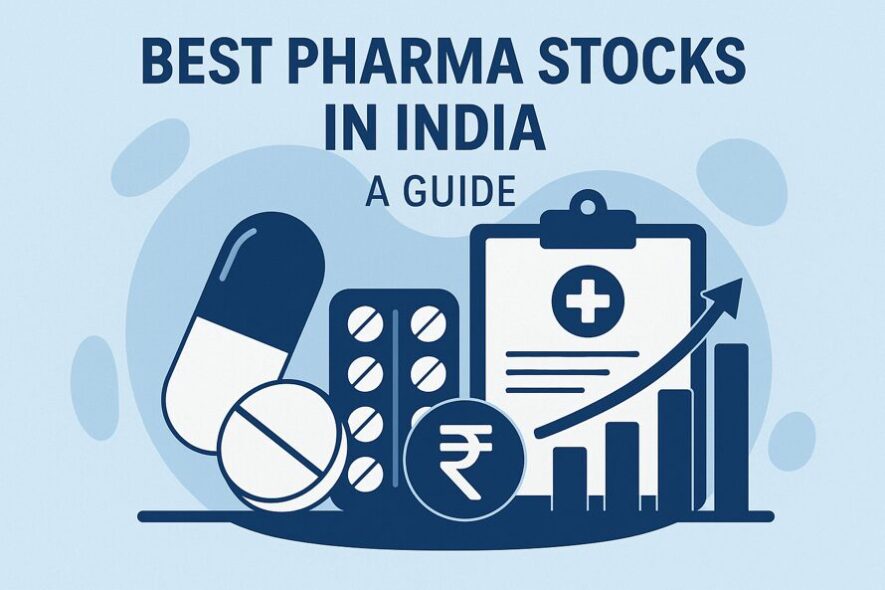
Introduction to India’s Pharma Sector
The global pharmaceutical industry is witnessing steady growth driven by several key factors, including rising healthcare spending. Pharma stocks have therefore emerged as an important investment avenue. In this blog post, we focus on the best pharma stocks to buy in India.
The Indian pharmaceutical sector has two major strengths: volume production + cost efficiency. Companies manufacture APIs, generic versions, and also invest in new drug research. Indian pharma has built a reputation for low-cost production, significant manufacturing capacity, and facilities with compliance certifications (USFDA, WHO-GMP, etc.).
Also, healthcare demand remains intact even in economic downturns. Even in recessions, people need meds. That gives pharma a resilient base. Combine that with rising domestic incomes, better access to healthcare, government focus on AMR/vaccination/health infrastructure, and global demand surges (vaccines, speciality drugs, biotech), and the pharma sector looks more than just stable. It’s buzzing with opportunity.
Why Invest in Pharma Stocks?
High Growth Potential & Innovation
Several companies are pushing R&D, patent filings, and biotech tie-ups. For example, Ajanta Pharma and Lupin are expanding in specialty drugs; Sun Pharma is pushing into dermatology and specialty biology. The possibility of getting a new drug approved or entering niche specialty markets means growth can be swift.
Innovation here isn’t just for big players. Mid-caps are trying formulations, delivery technologies, and the export of biologics. That potential drives investor interest. When regulation supports biotech/biosimilars, returns can leap.
Defensive Nature & Market Resilience
Medical demand does not drop significantly even in difficult times. While people cut down on non-essential spending, they still spend on critical health care. That makes the pharma sector defensive. Stocks like Cipla and Dr. Reddy’s often show less volatility during market corrections.
Also, policy protections (essential drugs, government procurement) help. Even when the market has low growth, essential medicines, vaccines, and generics keep revenue steady.
Export & Global Demand Drivers
India exports pharma products to the US, Europe, Africa, and Asia. Export gives foreign currency exposure and larger markets. Companies like Sun Pharma, Dr. Reddy’s, and Divi’s Laboratories have strong export earnings.
Global health trends (ageing population, chronic diseases, pandemics) boost demand. Vaccines, diagnostics, and specialty biologics are in huge demand globally. India is well-placed to supply many of these products. Also, regulatory approvals from the USFDA/EU/WHO help unlock markets and raise margins.
Criteria for Selecting the Best Pharma Stocks
Financial Health: Revenue, Margin & Debt
Select companies that demonstrate consistent and strong revenue growth year after year. Watch gross margin and net margin; if margins keep shrinking, risk rises. Also, check debt levels. Heavy debt burdens cost interest and drag when the market tightens.
Free cash flow matters too. Companies with strong cash flow can invest in R&D, scaling production, and weathering bad quarters without taking on massive debt.
R&D Pipeline & Innovation
Look beyond current product lines. Which companies have new drug candidates, patents, specialty drugs, or biosimilars in trial? R&D spend as a percentage of revenue is key. How many are in late-phase trials?
Innovation direction matters: specialty segments often yield higher margins. If a firm invests in advanced tech (e.g., biologics, gene therapies, or even diagnostics), you may see bigger long-term gains.
Regulatory Compliance & USFDA Approvals
Quality certifications, manufacturing facility inspections, and USFDA/EU/WHO approvals carry weight. Failures in inspections cost revenue and reputation. Companies that consistently clear regulatory audits (Sun Pharma specialty plants, Divi’s, etc.) often build trust and reduce risk.
Global Footprint & Export Markets
For pharma stocks, where you sell is as important as what you sell. Export helps diversify revenue risk. If a company sells only in India, then Indian policy/price control/currency moves will impact them severely. If it sells in the US/EU/Africa/LatAm, it hedges some domestic risk.
Dividend Yield & Shareholder Returns
Some pharma stocks pay dividends. Investors who want income + growth like this mix. Also, shareholder return includes buybacks and bonus shares. Companies with good payout policies often have stable cash flows and mature operations.
Top Pharma Stocks in India by Market Cap
Here is a list of pharma stocks, including large-caps, mid-caps, niche & emerging players. Data is as of mid-2025.
| Category | Stock | What’s special about the business? |
|---|---|---|
| Large-Cap Leaders | Sun Pharmaceutical Industries | India’s largest pharma company by market cap. Strong global specialty business. Good export revenue. |
| Dr. Reddy’s Laboratories | Strong R&D, global presence, stable generics & specialty mix. | |
| Cipla Ltd | Known for generics, OTC, respiratory + vaccine business. Good export reach. | |
| Mid-Cap High-Growth Picks | Lupin Ltd | Mid-cap with big growth potential in both domestic and export markets. Pipeline improving. |
| Aurobindo Pharma Ltd | Strong API business, global market exposure. Good scale. | |
| Torrent Pharmaceuticals | Known for branded generics, strong presence in niche therapies, and export exposure. | |
| Specialty & Niche Pharma Plays | Divi’s Laboratories | Very high margins, specialty chemicals & intermediates business, strong export and R&D. |
| Ajanta Pharma | Good brand presence, niche therapy focus, exporting to Africa / Asia. | |
| Emerging Biotech Innovators | Biocon Ltd | Biotech/biosimilars focus, potential in newer therapies, vaccine play. |
| Zydus Lifesciences | Balanced portfolio across generics + novel, good export + specialization in niche segments. |
Comparative Outlook: Large-cap vs. Mid-cap Pharma Stocks
Risk–Return Profile
Large-cap pharma stocks (like Sun Pharma, Dr. Reddy’s, Cipla) offer more predictable returns. They have scale, better compliance, and a larger product base. Their growth may be slower than small biotech, but less risky. Mid-caps and niche stocks can deliver high returns, sometimes 2- 3x in good cycles. But when things go wrong—read regulatory hiccups or pipeline failures—they tend to fall harder.
Volatility and Liquidity Considerations
Large caps tend to have better liquidity. You buy/sell with lower slippage. Mid/niche stocks may have low volumes and wider bid-ask spreads. That makes exits trickier. Also, mid-caps / niche names often swing more; news of FDA warning, regulation, patent expiry can cause sharp drops.
Investment Time Horizon
If you plan to hold for 5-10 years, mid-caps/niche plays can reward you if you pick wisely. If your horizon is shorter (1-3 years), large caps reduce the risk of a sudden drop. For those who need money sooner (education, short-term goals), leaning on large-cap leaders gives better stability.
How to Analyze Pharmaceutical Companies
Reading Financial Statements
Don’t just check revenue. Look at profit margins and gross margin trends over the years. Check if net margin is rising or falling. Look at debt vs equity; more debt means more risk if interest rates rise. Also, look at cash flow (operating & free cash flow).
Gauging R&D Investments
Check how much the company spends as a percentage of revenue on R&D. Also, track what’s in the pipeline: phases of trials, regulatory approvals awaiting, specialty vs generic pipeline. A good R&D pipeline reduces the risk of stagnation when older products go off patent.
Understanding Patent Expiry Impact
Many pharma companies face patent cliffs: when a drug loses exclusivity, cheaper generics undercut it. If a big chunk of revenue depends on one patent, expiry can hit margins hard. Check product mix, upcoming expiry dates, and whether there are replacement products in the pipeline.
Regulatory Risk Management
Check whether the company has passed recent inspections, whether they have any warning letters, import bans, or rejected approvals. Regulatory risk isn’t just about the USFDA; it can be Indian government-mandated price controls, changes in NPPA (National Pharmaceuticals Pricing Authority), or tax changes. Companies that maintain compliance, upgrade facilities, and diversify markets reduce that risk.
Impact of Global Trends on Indian Pharma Stocks
USFDA Inspections & Quality Approvals
USFDA approvals open big markets and bring higher margins. On the flip side, bad inspection reports can curtail exports, destroy trust, and lead to a revenue drop. For example, Sun Pharma’s specialty segment benefited well when its US facilities got approvals. Investors often reward firms that clear quality audits.
Geopolitical Factors & Supply Chains
Raw material sourcing, import duties, and global supply chain disruptions matter. If APIs come mainly from China, any import restriction, shipping delay, or tariff can push costs up. Also, trade policies, export restrictions, and foreign exchange moves influence profit significantly.
Mergers & Acquisitions in Pharma
M&A helps companies expand fast. When pharma firms acquire others (or get licensing deals), they add new products, manufacturing capability, or IP. For instance, the acquisition of specialty firms helps large caps add high-margin buyside. Also, licensing/patent tie-ups help with global reach without building everything from scratch.
Taxation & Regulatory Considerations for Investors
When you invest in pharma stocks (equity), your capital gains follow equity tax rules: short-term vs long-term. Dividends are taxable. Also, some pharma companies are impacted by government policies like NPPA price controls (essential medicines list), import taxes on raw materials, and regulatory changes for clinical trials.
Investors must watch announcements of drug price caps, duty changes, health ministry regulations, and foreign trade policy. Also, being aware of whether the facility has USFDA/EU/WHO certifications helps reduce risk.
Risks to Watch Out For
Pricing Control & Government Policies
The Indian government enforces price controls (NPPA) on essential drugs. This can limit profit margin on high-volume products. When the government increases regulation or changes policy (e.g. bans, reimbursements, price ceilings), some companies lose margin or face slower growth.
Regulatory Compliance Setbacks
Failed inspections or warning letters from the USFDA or global authorities damage reputation. Export orders can be cancelled. Such setbacks may stay on balance sheets as liabilities, causing stock dips. Beware of companies with a history of non-compliance.
R&D Failures or Pipeline Delays
Every drug in trial may or may not succeed. Trials cost money. A failure at a later phase after heavy investment can wipe out expected returns. Pipeline delays, regulatory delays, or safety concerns can stall revenue. Biotech/specialty names are especially sensitive.
How to Invest in Pharma Stocks: Strategy & Approach
Direct Stock Picking vs Thematic ETFs
If you enjoy reading financials, tracking approvals, and following regulations, direct stock picking gives higher rewards (with risk). But it demands effort. Thematic ETFs (if available) or pharma sector funds distribute risk across several companies. Balanced way: have core holdings in large caps + some exposure in mid / niche.
SIP in Pharma Funds
Using SIP (investing a fixed amount monthly) in pharma sector funds smooths out volatility. You onboard stock at different price points. A good strategy if you believe in long-term pharma growth.
Portfolio Allocation & Diversification
Don’t invest too much of your portfolio into the pharma sector alone. Spread across sectors: pharma, financials, consumption, etc. Also diversify inside pharma: large cap + mid cap + niche + export-oriented. That way, one bad regulation or policy change won’t wipe out your whole pharma exposure.
Conclusion
The pharmaceutical sector in India offers both strength and promise. Stocks like Sun Pharma, Dr. Reddy’s, and Cipla give stability and export scale. Mid-caps & niche plays like Divi’s Laboratories, Lupin, Ajanta Pharma, Biocon add growth potential.
If you apply strong criteria, such as financial health, R&D pipeline, regulatory compliance, global reach, and manage risk (diversify, monitor policy, and pick a horizon wisely), pharma stocks can become a powerful part of your long-term portfolio.
Seek balance: bet on growth, but hedge against regulation, oversight, and supply chain risk. If you stay informed and patient, pharma stocks can reward you handsomely.
FAQs:
Which is India’s largest pharma company by market cap?
Currently, Sun Pharmaceutical Industries holds the top spot as India’s largest pharma company by market capitalization. It leads in both domestic and international segments.
Are pharmaceutical stocks a good long-term investment?
Yes, pharma stocks can be solid long-term bets. The sector is known for steady demand, defensive traits, and exposure to global healthcare trends.
How often does USFDA approval impact Indian pharma stocks?
USFDA actions can significantly impact Indian pharma stocks. Approvals typically boost the stock price, while warnings or rejections often trigger sharp price drops.
Can small-cap pharma stocks give high returns?
They can, especially if the company has a strong product pipeline or gets global contracts. But small-caps carry higher risk and volatility.
Should I invest via pharma mutual funds or direct stocks?
If you’re new or prefer lower risk, pharma mutual funds offer diversification. Direct stock picking suits those who actively track the sector.
How do patent cliffs impact pharma stock performance?
When a drug patent expires, generic competitors enter the market. This often leads to a dip in revenue and can hurt stock prices unless new products are ready to fill the gap.
What are the key red flags in pharma stock analysis?
Watch out for USFDA issues, falling R&D spend, overdependence on one product or market, and declining margins. These could signal trouble ahead.




